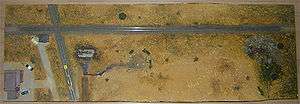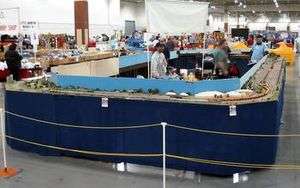NTrak
NTrak is one of several model railroad module standards. It is the most popular standard for use in United States N scale. NTrak allows modellers to participate in a large layout but only invest a small amount of space at their own home. They can interchange (connect and operate) their module with any club or group that follows NTrak standards.
History
The first prototype NTrak modules were designed and built by Ben Davis,[1] then they were first displayed in 1973 at the Model Railroad Industry Association show in Costa Mesa, California. Following their success at this show, the modules made their debut at the 1974 National Model Railroad Association's national convention in San Diego, California. Ben was a founding member of the Belmont Shores Model Railroad Club; the club, which has helped launch the model manufacturing careers of many of its members, is now considered by many as the organization where NTrak started.
Module standards
NTrak modules are marked by their standard three running tracks (two are "mainline" tracks and the third is the "branchline" track) that are required on all modules. These three tracks are set on 1.5-inch (38 mm) centers near the viewing side of the modules. The tracks are labeled from the viewing aisle by color, starting with Red for the outermost (closest to the viewing aisle) track, Yellow for the center track and Blue for the innermost track. The three tracks are electrically isolated from each other and from any other (optional) tracks on the module.[2]
Most modules are built with a surface area of 2 by 4 feet (0.61 by 1.22 m). The official standard allows up to an extra 6 inches (152.4 mm) of surface area on either the aisle or operator's side or both (which can lead to a module that is 3 feet (0.91 m) wide). Module lengths are typically extended in 2-foot (0.61 m) increments, but can be almost any length, limited by the modeler's abilities to build and transport the modules. Modules built to non-standard lengths must be built with consideration of the standard lengths; where appropriate, the modeler must also build a short bridge module so that the module set uses up a section of layout that is evenly divisible by 4-foot (1.22 m)-long modules.
Modules were originally connected electrically with 18 gauge wire utilizing two-conductor Cinch Jones 302 series connectors. The Anderson Powerpole PP30 connector and 12 gauge wire was adopted as a recommend practice in 2005. and as a standard for newly constructed modules in 2011.[3] The use of the older Cinch-Jones connector has been deprecated, but is still permitted on legacy modules.
In addition, new standards have been written to comply with the new National Fire Code. These include the prohibition of module-mounted power strips. These new standards are available for review at the NTRAK website.
Alternatives
In recent years other, often complementary, module standards have cropped up to address perceived deficiencies with NTrak's standard.
oNeTrak

One example of these perceived deficiencies is the requirement for NTrak modules to have three mainline tracks. On the prototype, except in a few areas where traffic density dictates the need for three (or more) mainline tracks, most mainlines throughout North America are single or double track.
oNeTrak is designed around the concept of a single track mainline and as such allows for a greater range of railroad scenes to be modeled compared to Ntrak. oNeTrak also allows for more prototypical operations as trains on a single track main often have to meet and/or pass each other during operation of the layout.
Smart-N
Smart-N is designed around the concept of a double track mainline. (Smart-N is now better referred to as T-Trak).
Bend Track
Bend Track is designed around a double track mainline which traverses each module twice, once on each side, with flexible module shape and no "pit" area.
See also
- Anderson Powerpole connector
References
External links
- NTrak Modular Railroading Society
- Belmont Shores Model Railroad Club - the first model club to build and operate NTrak modules.
- GermaNTRAK e.V. German and Austrian N-Trak Club (German)
- T-Trak Modular Layouts; Official Recommended Practices
- Northeast NTrak Modular Railroading Club
